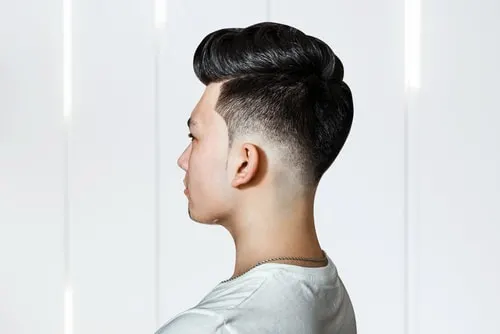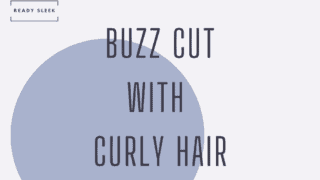Understanding the differences between the many types of fades out there is the first step toward getting the exact look you want. So, skin fade vs mid fade – what’s the difference?
Skin fades have the shortest length shaved down before they seamlessly blend into longer lengths further up. Mid fades can be any length, but the shortest length will start to increase around one inch above the ear. It’s important to note that mid fades can be skin fades.
That’s the short answer – let’s dig deeper.
After explaining the difference between these two terms in more detail, I’ll show you examples of each.
Skin Fade Vs Mid Fade: The Difference
A skin fade is an effect where the sides and back are shaved up until a certain point, before gradually increasing in length as you go further up.

Images From Deposit Photos and Shutterstockf
A mid fade is where the shortest length of the fade (which may or may not be shaved) only reaches around 1 inch above the ear before it gradually starts to increase in length further up.
The most important fact here is that a mid fade can be a skin fade. If the shortest length of the fade is shaved all the way down to the skin (as opposed to just clipped), it’s a skin fade.
If that shortest length (i.e shaved area) reaches around an inch above the ear before it starts to increase in length, it’s a “mid skin fade”.
So, the difference between skin fades and mid fades comes down to the fact that the term “skin fade” tells you about the length of the fade, while “mid fade” tells you about the height the fade reaches.
In a way, the two shouldn’t really be compared, but they often are and it often leads to confusion.
A mid fade can be a skin fade and vice versa.
Mid fades can also be non skin fades. In other words, the shortest length of the mid fade doesn’t necessarily need to be shaved.
You can get mid zero fades, mid 1 fades, mid 2 fades, and so on.
The difference between them comes down to how short the shortest length of the fade is before it starts to increase.
With a zero fade, the shortest length is clipped down to a number 0, while with a 1 fade it’s clipped down to a number 1.
What they all have in common is the fact that they’re mid fades and will all start to gradually and seamlessly increase in length approximately 1 inch above the ear.
This is compared with low fades which start to increase only around half an inch above the ear and compared with high fades which start to increase all the way up at the temples.
To sum that up – “skin fade” tells you about length while “mid fade” tells you how high up the fade is.
Skin Fade Vs Mid Fade: Examples
Here are some examples of skin fades and mid fades. I’ve thrown in a “mid skin fade” to show you that mid fades can definitely be skin fades in themselves.
Use these as a source of inspiration.
Low Skin Fade
A low skin fade is an effect where the sides and back are shaved up to approximately half an inch above the ear, at which point the hair gradually increases in length as you go further up.

As you can see from the photo, the shortest length of the fade is shaved – making it a “skin fade” by definition.
While skin fades can be mid fades too, this one is not, as the shortest length doesn’t reach as high up as an inch above the ear.
It’s a low fade, but more specifically a “drop fade”, because it “drops” in an arc-like fashion around the ear.
Mid Skin Fade
Here’s an example showing you how a fade can be both a mid fade and a skin fade at the same time.

As you can see, the shortest length is shaved all the way down, making it a skin fade.
But this shortest length reaches approximately one inch above the ear, making it a mid skin fade.
It’s quite high up for a mid fade but doesn’t reach as high as the temples. That’s why it should more correctly be called a mid fade and not a high fade.
High Skin Fade
A high skin fade is an effect where the sides and back are shaved up to around the level of the temples before it gradually starts to increase in length.

It’s a pretty bold and striking look – great for anyone looking to make a statement. Just know that when the skin fade is this high up, the fade itself becomes a focus of the entire hairstyle as a whole.
It isn’t subtle, but in many ways – that’s its appeal.
Mid 1 Fade
This is an example of a “mid 1 fade” because the shortest length of the fade is a number 1 length (3mm) clipped using a #1 guard. It’s a mid fade because the #1 length reaches around an inch above the ear before it seamlessly starts to blend into longer lengths.

It’s a good example of how a fade can be included within practically any hairstyle you can think of.
This should be called an undercut, because there is a harsh transition between the top and the sides, with the hair on the top left long and slicked back.
The fade also looks great combined with the beard that tapers into it smoothly.
Mid Zero Fade
Finally, this is an example of a mid fade where the shortest length is clipped down to a #0 length before it starts to increase around an inch above the ear.

While it looks similar to a mid skin fade, you can clearly see a light layer of stubble beneath the fade level. It hasn’t been shaved all the way down.
It’s more likely to have been achieved using a pair of clippers with no guard attached. In other words, it’s a zero fade.
Conclusion
After reading this, you should hopefully have a better understanding of the difference between these two terms.
These are the key points to take away:
- “Mid fade” tells you about the height of the fade, while “skin fade” tells you about the shortest length of the fade.
- Mid fades can be skin fades and skin fades can be mid fades.
Knowing the differences between these commonly used terms is essential when communicating with a barber.
Ending up with a fade that was never wanted in the first place is often the result of a misunderstanding.
Hopefully, that’s now a lot less likely to occur.
Enjoy.
Ready Sleek founder. Obsessed with casual style and the minimalist approach to building a highly functional wardrobe. Also a fan of classic, vintage hairstyles.

![Skin Fade Vs Mid Fade: What’s The Difference? [Pics]](https://www.readysleek.com/wp-content/uploads/2021/11/Skin-fade-vs-mid-fade-720x405.jpeg)





